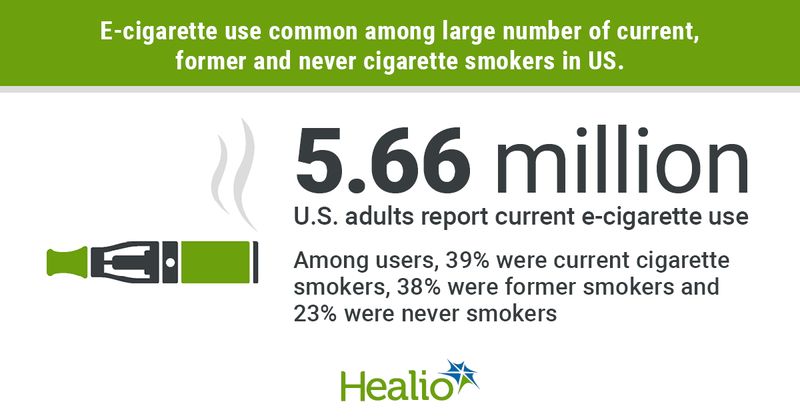2.3% of US population reports current e-cigarette use
The prevalence of e-cigarette use increased from 2018 to 2019 among current, former and never adult smokers in the United States, according to data published in JAMA Network Open.
Researchers examined the distribution of e-cigarette use among 135,211 adults (mean age, 47.5 years; 52% women) from the 2018-2019 Tobacco Use Supplement to the Current Population Survey to examine current e-cigarette use by demographic characteristics and cigarette smoking status.

Of those, 11.4% were current smokers, 18.2% were former smokers and 70.3% were never smokers.
More than 5.66 million U.S. adults, or 2.3%, reported current vaping, the majority of whom were current or former smokers. Among e-cigarette users, more than 2.21 million (39.1%) were current smokers, more than 2.14 million (37.9%) were former smokers and more than 1.3 million (23.1%) were never smokers.

Vaping prevalence was higher among men (2.8%) and non-Hispanic white individuals (2.8%), American Indian/Alaskan Native individuals (4.2%) and multiracial individuals (4.5%).
Researchers reported a larger increase in vaping prevalence with increasing education: less than high school (2.2%), high school degree (3%) and some college (3.1%). The prevalence was lower among those with a college degree (1.2%).
Among never smokers who reported e-cigarette use, 63.4% were aged 18 to 24 years and 23.8% were aged 25 to 34 years. E-cigarette users who were current or former smokers were aged 35 to 64 years.
Those who used both cigarettes and e-cigarettes (69.3%) and former smokers who reported current e-cigarette use (80.7%) reported using e-cigarettes to aid in smoking cessation.
“We found that the majority of both current and former smokers who were currently vaping reported using e-cigarettes to try to quit smoking, but longitudinal studies and trials are needed in order to determine whether vaping actually helps smokers quit cigarettes,” Margaret Mayer, PhD, MPH, the Cancer Research Training Award Fellow in the Tobacco Control Research Branch of the Behavioral Research Program in the Division of Cancer Control and Population Sciences at the National Cancer Institute at the NIH, told Healio. “These findings raise concerns about the potential long-term health effects of dual use among current smokers and about smoking relapse among former smokers.”
Mayer recommended that smokers quit all tobacco products, including e-cigarettes.
“E-cigarettes are not FDA approved for smoking cessation, and the recent Surgeon General’s Report on Smoking Cessation concluded that there was insufficient evidence to say that they are effective,” Mayer said,
Research on the health effects of e-cigarette use, alone or combined with cigarette smoking, continues to be critical, according to Mayer.
“It will also be important for researchers to continue studying initiation and prevention of e-cigarette use among young people,” Mayer said. “Our study found that, among adults, most never-smoking e-cigarette users were young, which is alarming considering the potential for long-term nicotine addiction and other health risks.”
For more information:
Margaret Mayer, PhD, MPH, can be reached at margaret.mayer@nih.gov.
